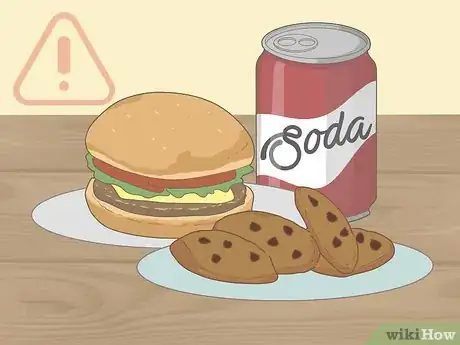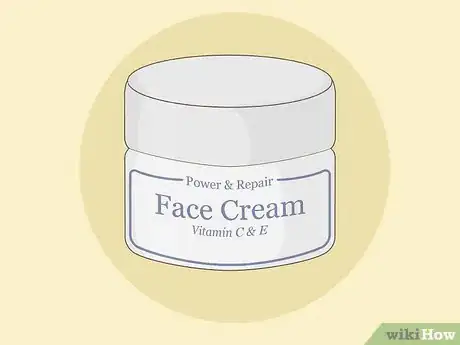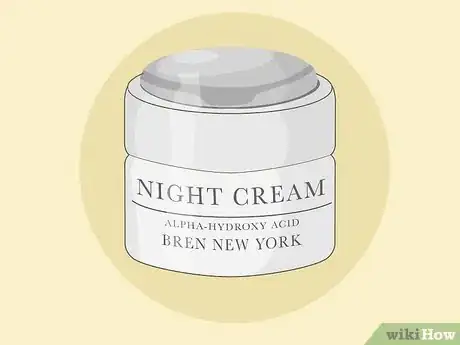This article was co-authored by Joanna Kula. Joanna Kula is a Licensed Esthetician, Owner and Founder of Skin Devotee Facial Studio in Philadelphia. With over 10 years of experience in skincare, Joanna specializes in transformative facial treatments to help clients achieve a lifetime of healthy, beautiful, and radiant skin. She is also a contributing author for the prestigious Les Nouvelles Esthetiques & Spa magazine and has been featured in a number of magazines including InStyle.
This article has been viewed 37,186 times.
To many people, slightly stretchy, elastic skin connotes youth and good health. As people age, though, their skin often loses some of its collagen—the fibers that keep skin looking young and elastic—and begins to sag, stretch, and wrinkle. If you’d like to keep some elasticity to your skin, there are a few straightforward steps you can take, including cutting out smoking and eating a healthy diet. Also try retinol creams and anti-aging creams that are high in antioxidants to keep the collagen in your skin healthy.
Steps
Maintaining Elasticity through Lifestyle Changes
-
1Wear sunscreen and a hat when you step out into the sun. Over time, exposure to the sun’s UV rays will take a toll on the elasticity of your skin. The best way you can keep your skin looking young is by protecting it from the sun. If you’re going to be outside for more than 15–20 minutes, slather on a high-SPF sunscreen and wear a hat to protect the skin on your face and head.[1]
- These protective measures will also protect your skin against melanoma and other forms of skin cancer.
-
2Stop smoking to prevent skin from wrinkling and sagging. Chemicals found in cigarettes, cigars, and other smoking devices accelerate the aging process of skin across your body. Heavy smokers as young as 30 may begin to notice that they’re already losing skin elasticity and developing wrinkles. To reverse this unhealthy process, stop smoking as soon as possible, even if you only smoke infrequently.[2]
- Fortunately, your skin can repair itself, and it will regain some of its youthful elasticity in the weeks and months after you cut out smoking.
Advertisement -
3Sleep at least 7–9 hours a night so your body can regenerate collagen. While you’re sleeping, your body produces collagen and fights off free radicals that would otherwise break down the elasticity in your skin. If you’re an adult between the ages of 26 and 64, try to get a full 7–9 hours nightly.[3]
- If you routinely sleep fewer than 6 hours a night, you’ll soon start to notice that your skin has lost elasticity and looks older and more wrinkly.
Helping Your Skin with Diet and Exercise
-
1Exercise for 30 minutes at least 3–4 times a week. Weekly exercise will strengthen your muscles and tighten up your skin, making it look younger and more elastic. Regular exercise also helps your skin by increasing circulation, which in turn brings more blood to your skin and speeds up production of collagen.[4]
- To maintain your skin’s elasticity, try medium-intensity exercises like running, swimming, or jumping rope.
- If you have a busy schedule, try to find 2 short periods during your day in which you can exercise. For example, visit your office gym for 15 minutes on the treadmill during lunch, and swim at a community-center pool for 20 minutes in the evening.
-
2Incorporate foods rich in zinc, vitamin C, and omega-3 into your diet. In general, a healthy diet rich in whole grains and lean meats will keep your skin healthy and elastic.[5] More specifically, zinc, vitamin C, and omega-3 fats are great nutrients for your skin, as they allow the skin to repair itself from damage (e.g., due to sun exposure) and to regenerate new collagen.[6]
- You can find vitamin C in oranges (and orange juice), sweet peppers, Brussels sprouts, kiwi, and strawberries.
- Zinc can be found in foods like fatty fish (like salmon), walnuts, almonds, dairy products, eggs, and green leafy vegetables.
- Foods rich in omega-3 fatty acids include many varieties of fish, walnuts, avocados, and flax seeds.[7]
-
3Keep your body hydrated by drinking plenty of water each day. Moisturizing your skin isn’t all about creams and lotions. It’s also important to keep your body hydrated in general. If your body gets dehydrated, your skin will suffer and lose some of its elasticity. Dehydrated skin will look dry, flaky, and will also show signs of wrinkling earlier than well-hydrated skin.[8]
- Adult men should drink 15.5 cups (3.7 L) of water each day, while adult women should drink at least 11.5 cups (2.7 L).[9]
-
4Limit your consumption of foods rich in sugar and corn syrup. Although sugary, sweet foods are among the most delicious, they’re typically unhealthy and low in beneficial nutrients. In addition, when sugar, corn syrup, and dextrose build up in your bloodstream, they create molecules called “glycation end products” that break down cellulose in your skin. As a result, your skin may begin to wrinkle and lose its elasticity.[10]
- Adults who eat an average of 2,000 calories per day should limit their sugar and corn syrup consumption to only about 200 calories per day.
- 200 calories equal about 12 teaspoons (48 g) of added sugars a day.
Using Anti-Aging Creams
-
1Apply anti-aging creams that are high in antioxidants. Antioxidants are very good for your skin; they preserve collagen and maintain your skin’s elasticity. Make sure that the cream you purchase contains both vitamin C and vitamin E, since these antioxidants work best in combination. Follow the directions on the packaging and apply antioxidant anti-aging creams daily for best results.[11]
- Purchase anti-aging skin creams at any large drugstore or pharmacy.
- Be aware that, since these products are not technically drugs, they haven’t been put through the rigorous testing processes that drugs have and may not fulfill all of the claims on the packaging.
-
2Look for anti-wrinkle creams that contain retinol. If you’re less concerned about the elasticity of your skin overall and more concerned with preventing facial wrinkles, a retinal cream is your best bet. Retinol is a vitamin A compound that, when applied to skin on a daily basis, can increase the skin’s elasticity. The compound works by breaking down free radicals in your skin and preserving the collagen in skin cells.[12]
- Apply the cream 1–2 times a day as directed on the packaging. Keep it up for at least a month, since it’ll most likely take that long for you to notice any results.
-
3Use hydroxy acids to remove dead skin and encourage elasticity. Skincare creams and other products that contain these acids will exfoliate the upper layers of your skin, wearing away and removing dead and wrinkle-producing skin cells. This chemical exfoliation will expose younger and more elastic skin, and should also stimulate this new skin to grow evenly and retain its elasticity.[13]
- The family of hydroxy acids includes alpha hydroxy, beta hydroxy, and poly hydroxy acids. Beta hydroxy is also known as salicylic acid.
- Purchase skincare products containing hydroxy acids at any large drugstore or pharmacy. They’re also available through major online retailers.
-
4Visit a dermatologist for a prescription-strength anti-aging cream. If you’ve used an over-the-counter skincare product (e.g., a retinol cream) for several months with no noticeable effect, ask your general practitioner to refer you to a dermatologist. The dermatologist can write you a prescription for a high-strength cream that will aggressively rejuvenate collagen and increase your skin’s elasticity.[14]
- If your skin has sustained serious sun damage or has lost nearly all of its collagen, the dermatologist may suggest an invasive procedure such as Botox injections or a skin-resurfacing procedure.
Expert Q&A
Did you know you can get expert answers for this article?
Unlock expert answers by supporting wikiHow
-
QuestionWhich foods have a lot of omega-3 fatty acids?
 Joanna KulaJoanna Kula is a Licensed Esthetician, Owner and Founder of Skin Devotee Facial Studio in Philadelphia. With over 10 years of experience in skincare, Joanna specializes in transformative facial treatments to help clients achieve a lifetime of healthy, beautiful, and radiant skin. She is also a contributing author for the prestigious Les Nouvelles Esthetiques & Spa magazine and has been featured in a number of magazines including InStyle.
Joanna KulaJoanna Kula is a Licensed Esthetician, Owner and Founder of Skin Devotee Facial Studio in Philadelphia. With over 10 years of experience in skincare, Joanna specializes in transformative facial treatments to help clients achieve a lifetime of healthy, beautiful, and radiant skin. She is also a contributing author for the prestigious Les Nouvelles Esthetiques & Spa magazine and has been featured in a number of magazines including InStyle.
Licensed Esthetician
References
- ↑ https://www.oglf.org/improve-skin-elasticity/
- ↑ https://www.oglf.org/improve-skin-elasticity/
- ↑ https://www.oglf.org/improve-skin-elasticity/
- ↑ https://www.oglf.org/improve-skin-elasticity/
- ↑ https://www.allure.com/story/how-to-get-firm-skin
- ↑ Kula, Joanna. Personal interview. 9 July 2019.
- ↑ Kula, Joanna. Personal interview. 9 July 2019.
- ↑ https://www.oglf.org/improve-skin-elasticity/
- ↑ https://www.mayoclinic.org/healthy-lifestyle/nutrition-and-healthy-eating/in-depth/water/art-20044256
- ↑ https://www.allure.com/story/how-to-get-firm-skin
- ↑ https://www.ncbi.nlm.nih.gov/pmc/articles/PMC3583892/
- ↑ https://www.mayoclinic.org/diseases-conditions/wrinkles/in-depth/wrinkle-creams/art-20047463
- ↑ https://www.mayoclinic.org/diseases-conditions/wrinkles/in-depth/wrinkle-creams/art-20047463
- ↑ https://www.mayoclinic.org/diseases-conditions/wrinkles/in-depth/wrinkle-creams/art-20047463
- ↑ https://www.allure.com/story/how-to-get-firm-skin

















-Step-12-Version-3.webp)



















































